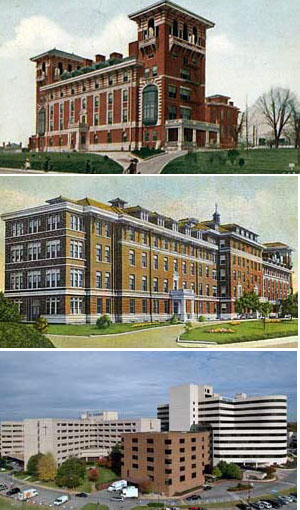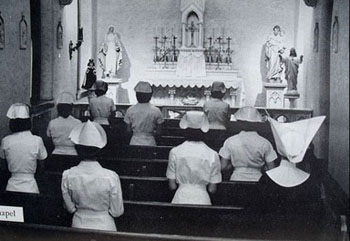Consequences of Vatican II
 |
 |
 |
 |
 |
 |
 |
Sisters in Crisis - I
No More Daughters of Charity
at Nashville Hospital
A progressivist newspaper based in Kansas City, the National Catholic Reporter, recently received a $2.3 million grant to cover religious sisters locally and globally. Behold, the Sisters’ Stories series appears, tales about how vibrant and strong Catholic sisters supposedly still are, and the different “issues” they face. The series aims to show that even though Orders have admittedly shrunk a great deal, they still face a “bright future.”
I say tales, because they are fairy tales for anyone who observes reality. To counter this misinformation from the progressivist camp, today a series titled Sisters in Crisis begins on TIA website. It looks at different Orders of our old teaching and nursing sisters in the United States to see the dismal, disastrous remains of this once thriving, strong Catholic presence in so many cities in our country.
Today, the Daughters of Charity in Nashville, Tennessee, are featured. They were nursing sisters who engraved their Catholic presence on this primarily Protestant city.
*
Recently it was announced that the Daughters of Charity will withdraw from the Nashville Diocese in the Fall of 2014. Thus, for the first time since the sisters came to Nashville in 1898 to establish St. Thomas Hospital, no Daughters of Charity will be serving the hospital and its clinics. (Catholic News Service, Oct. 15, 2013)
Unfortunately, the story is a familiar one. A Catholic hospital once under the administration of religious sisters and staffed chiefly by them is gradually secularized. The chief reason for this is the lack of younger sisters coming up to replace the older ones; of course, the primary cause for this dearth of sisters is the “reform” of women religious instituted by Vatican II.
The story of St. Thomas Hospital
In 1898 Nashville Bishop, Thomas Sebastian Byrne, invited the Daughters of Charity of St. Vincent de Paul to his Diocese to establish a hospital, certain it would do much good for the community. The Bishop bought a mansion home in a residential West End neighborhood on Church Street and converted it into a hospital. On April 11, 1898 St. Thomas Sanatorium was born.
 Under the capable direction of Sister Scholastica, the Mother Superior, the hospital grew. In 1902, a new building of red bricks with arched roof towers on either end was constructed to meet growing needs. A nursing school directed by the Daughters became a part of the program, and the St. Thomas facility rapidly became one of the leading hospitals of the South.
Under the capable direction of Sister Scholastica, the Mother Superior, the hospital grew. In 1902, a new building of red bricks with arched roof towers on either end was constructed to meet growing needs. A nursing school directed by the Daughters became a part of the program, and the St. Thomas facility rapidly became one of the leading hospitals of the South.
An obituary of Sister Scholastica gives us an idea of how the sisters became an integral and loved part of the community. For 24 years, this dedicated sister and trained nurse headed St. Thomas Hospital. When she died, the Arkansas Catholic recalled her life as “as one of constant sacrifice and heroic deeds, not only in the business administration of a great institution, but in the little deeds that are so seldom mentioned.”
Her life work, “filled with acts of mercy, administering kindness to the suffering and wise counsel to the misguided” earned for her and her Order of Sisters the respect “not only of Catholics, but people of all creeds and religions, from the most lowly walks of life to the highest.”
The competence, energy and expertise of the nursing Daughters of Charity made them much in demand. But it was something more that won them the love and devotion of the people they served. In their distinctive grey habit with the white cornette, these sisters embodied lives of sacrifice. They received no personal salaries, they renounced the social amenities and feminine vanities of the world - all with the aim of serving Christ and seeing Him in the suffering sick of humanity. Such a noble mission reflected in the demeanor and person of each sister, who became a symbol of the model selfless nurse.
Post-conciliar changes
After Vatican II, however, things started to change. No more triangular white cornettes were seen in the hospital halls. The Sisters now were in modified habits or secular dress. Soon, the vocations started to diminish and the School of Nursing closed.
In 1975 the old St. Thomas Hospital was torn down to make way for a parking lot and the current thoroughly modern institution opened on Harding Road. Then, following the general trend in hospital administration, St. Thomas Hospital became a part of St. Thomas Health, a conglomerate of hospitals of different denominations and a network of affiliated clinics, services and rehabilitation facilities.
Finally, in 2002, St. Thomas and Baptist Hospitals merged as St. Thomas Health. Like so many other hospitals, St. Thomas no longer calls itself Catholic, but rather “a faith based ministry.”
 The Sisters who remained were professionals, dressed for a time in modified habits and finally just in lay clothing. The traditional vows of the Daughters of Charity were redefined for the 21st century: for example, the vow of obedience was replaced by an ambiguous vow of dependence, and the vow of poverty practically disappeared when the sisters began to have budgets and spending money to use as they pleased. The vow of obedience was considered obsolete, a remnant of a hierarchical world of rulers and underlings.
The Sisters who remained were professionals, dressed for a time in modified habits and finally just in lay clothing. The traditional vows of the Daughters of Charity were redefined for the 21st century: for example, the vow of obedience was replaced by an ambiguous vow of dependence, and the vow of poverty practically disappeared when the sisters began to have budgets and spending money to use as they pleased. The vow of obedience was considered obsolete, a remnant of a hierarchical world of rulers and underlings.
So, Sisters began to choose their own ministries and merely “consult” regarding a “change in ministry.” A “member” of an Order is rarely, if ever, ordered to do or not do something. (See “Traditional vows redefined for the 21st century,” NPR, June 15, 2013)
Let us look, for example, at Sister Naomi, the last Daughter of Charity at St. Thomas. Like most other sisters of the Order, she was not even carrying out a nursing role. A paid employee with a full benefits package, she was part of the Hospital’s “pastoral care” team from 2011 until her retirement this year. Her past “career” included directing the North Nashville Outreach Program of Catholic Charities.
Careers, salaries and retirement were not part of the vocabulary of the pre-conciliar Daughters of Charity.
New modern ministries
A spokesman for St. Thomas Health, Dr. Mike Schatzlein, pretends that the Daughters are leaving because they have other urgent “ministries” that better meet their mission “to serve the poorest of the poor.” The real reason, however, is the clear decrease in the number of sisters and the growing number of elderly sisters who can no longer give care, but need it for themselves.
 The mission of the Daughters of Charity is to seek Christ in the poor, thus their motto “The Charity of Jesus Christ crucified urges us.” The post-conciliar Church falsely claims that the emphasis in Religious Orders has shifted to a more effective serving the poor, as if the Catholic Church prior to Vatican II were somehow deficient in this sphere.
The mission of the Daughters of Charity is to seek Christ in the poor, thus their motto “The Charity of Jesus Christ crucified urges us.” The post-conciliar Church falsely claims that the emphasis in Religious Orders has shifted to a more effective serving the poor, as if the Catholic Church prior to Vatican II were somehow deficient in this sphere.
The truth, however, is that before the changes in women religious orders that ‘liberated’ them from a supposedly harsh past, the work of the nursing Daughters of Charity flourished, their hospitals prospered and grew, and their numbers multiplied to keep up with the labor. Then, there was no lack of idealistic girls eager to embrace a life of sacrifice without financial remuneration for the love of Christ.
After 50 years of Vatican II, this once thriving nursing Order of the Daughters of Charity in Nashville has faded away and is soon to become no more than a local memory. This is not the story of “progress” and vitality that the progressivist media presents as a fruit of the Council…
Continued

Posted November 1, 2013
I say tales, because they are fairy tales for anyone who observes reality. To counter this misinformation from the progressivist camp, today a series titled Sisters in Crisis begins on TIA website. It looks at different Orders of our old teaching and nursing sisters in the United States to see the dismal, disastrous remains of this once thriving, strong Catholic presence in so many cities in our country.
Today, the Daughters of Charity in Nashville, Tennessee, are featured. They were nursing sisters who engraved their Catholic presence on this primarily Protestant city.
Recently it was announced that the Daughters of Charity will withdraw from the Nashville Diocese in the Fall of 2014. Thus, for the first time since the sisters came to Nashville in 1898 to establish St. Thomas Hospital, no Daughters of Charity will be serving the hospital and its clinics. (Catholic News Service, Oct. 15, 2013)
Unfortunately, the story is a familiar one. A Catholic hospital once under the administration of religious sisters and staffed chiefly by them is gradually secularized. The chief reason for this is the lack of younger sisters coming up to replace the older ones; of course, the primary cause for this dearth of sisters is the “reform” of women religious instituted by Vatican II.
The story of St. Thomas Hospital
In 1898 Nashville Bishop, Thomas Sebastian Byrne, invited the Daughters of Charity of St. Vincent de Paul to his Diocese to establish a hospital, certain it would do much good for the community. The Bishop bought a mansion home in a residential West End neighborhood on Church Street and converted it into a hospital. On April 11, 1898 St. Thomas Sanatorium was born.

St. Thomas, from its beginnings founded by the Daughters of Charity, to the present day modern institution in Nashville
An obituary of Sister Scholastica gives us an idea of how the sisters became an integral and loved part of the community. For 24 years, this dedicated sister and trained nurse headed St. Thomas Hospital. When she died, the Arkansas Catholic recalled her life as “as one of constant sacrifice and heroic deeds, not only in the business administration of a great institution, but in the little deeds that are so seldom mentioned.”
Her life work, “filled with acts of mercy, administering kindness to the suffering and wise counsel to the misguided” earned for her and her Order of Sisters the respect “not only of Catholics, but people of all creeds and religions, from the most lowly walks of life to the highest.”
The competence, energy and expertise of the nursing Daughters of Charity made them much in demand. But it was something more that won them the love and devotion of the people they served. In their distinctive grey habit with the white cornette, these sisters embodied lives of sacrifice. They received no personal salaries, they renounced the social amenities and feminine vanities of the world - all with the aim of serving Christ and seeing Him in the suffering sick of humanity. Such a noble mission reflected in the demeanor and person of each sister, who became a symbol of the model selfless nurse.
Post-conciliar changes
After Vatican II, however, things started to change. No more triangular white cornettes were seen in the hospital halls. The Sisters now were in modified habits or secular dress. Soon, the vocations started to diminish and the School of Nursing closed.
In 1975 the old St. Thomas Hospital was torn down to make way for a parking lot and the current thoroughly modern institution opened on Harding Road. Then, following the general trend in hospital administration, St. Thomas Hospital became a part of St. Thomas Health, a conglomerate of hospitals of different denominations and a network of affiliated clinics, services and rehabilitation facilities.
Finally, in 2002, St. Thomas and Baptist Hospitals merged as St. Thomas Health. Like so many other hospitals, St. Thomas no longer calls itself Catholic, but rather “a faith based ministry.”

Sister Naomi, the modern Daughter of Charity sans habit
So, Sisters began to choose their own ministries and merely “consult” regarding a “change in ministry.” A “member” of an Order is rarely, if ever, ordered to do or not do something. (See “Traditional vows redefined for the 21st century,” NPR, June 15, 2013)
Let us look, for example, at Sister Naomi, the last Daughter of Charity at St. Thomas. Like most other sisters of the Order, she was not even carrying out a nursing role. A paid employee with a full benefits package, she was part of the Hospital’s “pastoral care” team from 2011 until her retirement this year. Her past “career” included directing the North Nashville Outreach Program of Catholic Charities.
Careers, salaries and retirement were not part of the vocabulary of the pre-conciliar Daughters of Charity.
New modern ministries
A spokesman for St. Thomas Health, Dr. Mike Schatzlein, pretends that the Daughters are leaving because they have other urgent “ministries” that better meet their mission “to serve the poorest of the poor.” The real reason, however, is the clear decrease in the number of sisters and the growing number of elderly sisters who can no longer give care, but need it for themselves.

A Daughter of Charity at right in the chapel, symbol of a life of dedication and sacrifice
The truth, however, is that before the changes in women religious orders that ‘liberated’ them from a supposedly harsh past, the work of the nursing Daughters of Charity flourished, their hospitals prospered and grew, and their numbers multiplied to keep up with the labor. Then, there was no lack of idealistic girls eager to embrace a life of sacrifice without financial remuneration for the love of Christ.
After 50 years of Vatican II, this once thriving nursing Order of the Daughters of Charity in Nashville has faded away and is soon to become no more than a local memory. This is not the story of “progress” and vitality that the progressivist media presents as a fruit of the Council…
Continued

Posted November 1, 2013
______________________
______________________



